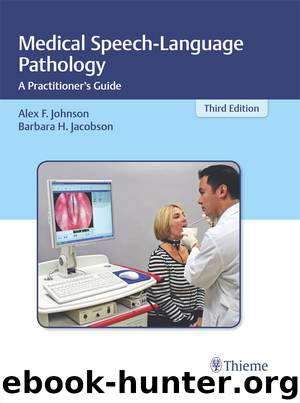Medical Speech-Language Pathology by Alex F. Johnson Barbara H. Jacobson

Author:Alex F. Johnson,Barbara H. Jacobson
Language: eng
Format: epub
Publisher: Thieme Medical Publishing Inc.
Published: 2017-02-28T16:00:00+00:00
13 Rehabilitation of the Head and Neck Cancer Patient
Donna Graville, Andrew Palmer, and Peter Andersen
13.1 Introduction
The term head and neck cancer (HNC) refers to a myriad of malignant diseases of the head and neck, including not only cancers of the upper aerodigestive tract but also cancers of the skin, salivary glands, thyroid gland, nasal cavity, paranasal sinuses, bone, and cartilage, and metastatic tumors from other body sites. However, in general usage it is most commonly used to describe squamous cell carcinoma of the oral cavity, oropharynx, hypopharynx, and larynx. This chapter focuses on the treatment and rehabilitation of the aforementioned patients but the principles and techniques described can be easily extrapolated to the treatment of patients with less common tumors of the head and neck.
The dominant histology of HNC is squamous cell carcinoma (SCC), which comprises more than 80% of cases in the United States. While the overall incidence of HNC has remained stable over the last several decades, there have been changes in the incidence of cancer in certain sites. Incidence has risen for the oral cavity, oropharynx, and thyroid gland, and fallen for the hypopharynx and larynx. Currently, it is estimated that there will be more than 40,000 new cases of cancer of the oral cavity and pharynx in the U.S. each year. 1 The mortality has fallen during the same time frame for cancer at all sites except thyroid cancer, for which the mortality rate has remained stable. 2 The rising incidence of thyroid cancer has been ascribed to an increase in diagnosis of previously undetected thyroid cancers but this proposition is not universally accepted. 3
SCC of the head and neck has traditionally been associated with the use of tobacco and alcohol. Those who both smoke and drink have a greatly increased risk of developing SCC of the head and neck, which suggests that the two activities act synergistically to promote the development of cancer. 4 However, a subset of perhaps 20% of patients lack the typical risk factors for head and neck SCC. Recent discoveries have indicated that infection with high-risk types of human papilloma virus (HPV) is an independent risk factor for the development of SCC of the head and neck, particularly in the tonsil and base of the tongue. 5, 6 Recent studies have found an increasing incidence of HPV-associated oropharyngeal cancers in white men and women. 1 There is good evidence that some patients whose tumor is caused by HPV may have a better prognosis, and in the future the treatment of patients may, in part, be determined by their HPV status, but it is not yet certain whether this is possible and, if possible, what changes will result. 7
The diagnosis of HNC represents a tremendous burden to the patient. Both the tumor itself and the treatment needed to address it result in problems affecting numerous domains of human functioning. The head and neck are vital not only for life but also for how we generally interact with society. Treatment can affect not only the ability to eat and speak, but also sight, hearing, sense of smell, and appearance.
Download
This site does not store any files on its server. We only index and link to content provided by other sites. Please contact the content providers to delete copyright contents if any and email us, we'll remove relevant links or contents immediately.
| Anesthesiology | Colon & Rectal |
| General Surgery | Laparoscopic & Robotic |
| Neurosurgery | Ophthalmology |
| Oral & Maxillofacial | Orthopedics |
| Otolaryngology | Plastic |
| Thoracic & Vascular | Transplants |
| Trauma |
Periodization Training for Sports by Tudor Bompa(8171)
Why We Sleep: Unlocking the Power of Sleep and Dreams by Matthew Walker(6618)
Paper Towns by Green John(5092)
The Immortal Life of Henrietta Lacks by Rebecca Skloot(4526)
The Sports Rules Book by Human Kinetics(4295)
Dynamic Alignment Through Imagery by Eric Franklin(4118)
ACSM's Complete Guide to Fitness & Health by ACSM(3989)
Kaplan MCAT Organic Chemistry Review: Created for MCAT 2015 (Kaplan Test Prep) by Kaplan(3940)
Introduction to Kinesiology by Shirl J. Hoffman(3726)
Livewired by David Eagleman(3684)
The Death of the Heart by Elizabeth Bowen(3552)
The River of Consciousness by Oliver Sacks(3541)
Alchemy and Alchemists by C. J. S. Thompson(3451)
Bad Pharma by Ben Goldacre(3357)
Descartes' Error by Antonio Damasio(3230)
The Emperor of All Maladies: A Biography of Cancer by Siddhartha Mukherjee(3068)
The Gene: An Intimate History by Siddhartha Mukherjee(3048)
The Fate of Rome: Climate, Disease, and the End of an Empire (The Princeton History of the Ancient World) by Kyle Harper(3003)
Kaplan MCAT Behavioral Sciences Review: Created for MCAT 2015 (Kaplan Test Prep) by Kaplan(2940)
